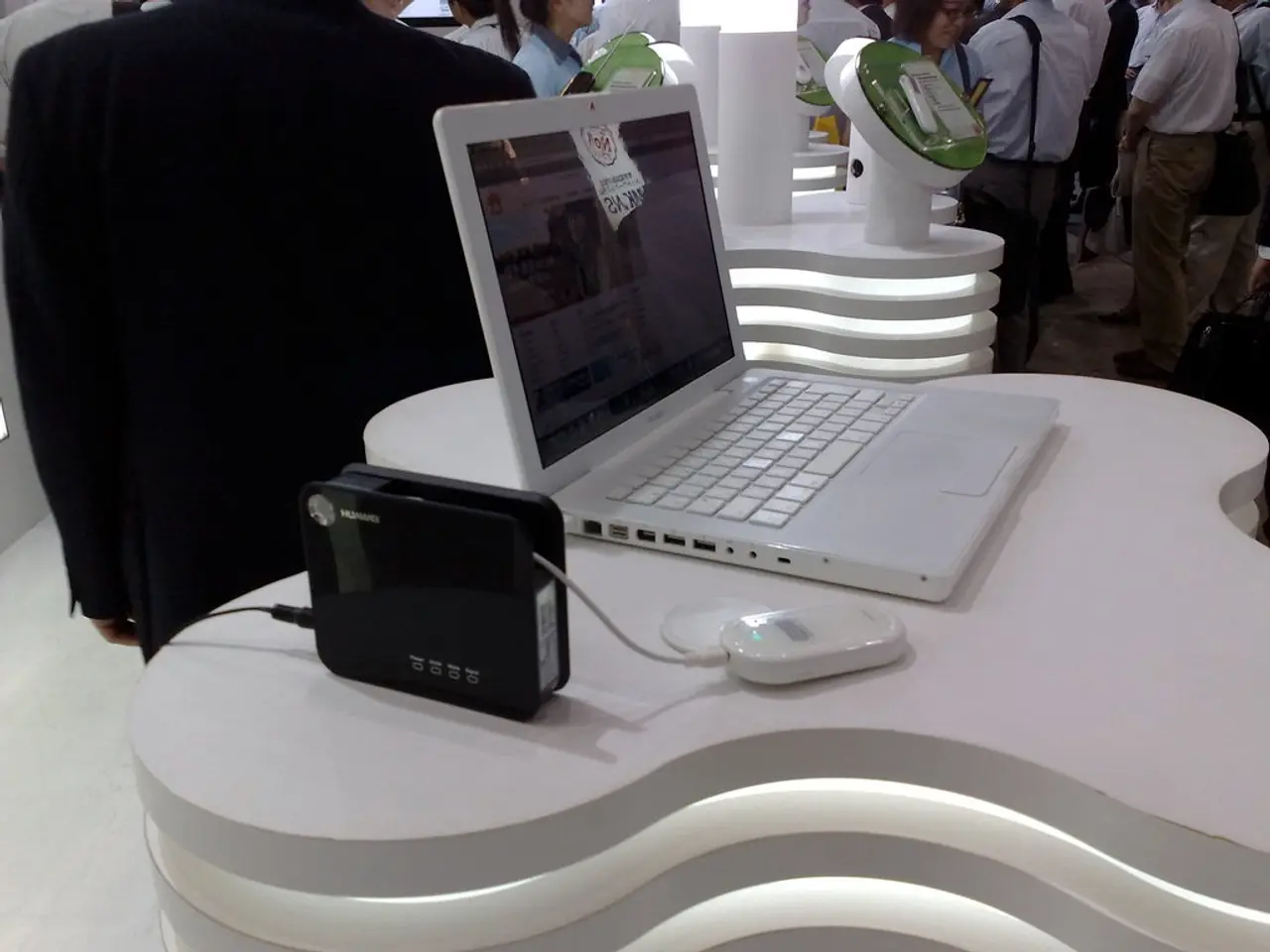Nvidia's Blackwell laptop equipped with RTX Pro 5000 outperforms its predecessor by 14% in OpenCL benchmark, showing a similar performance to a laptop RTX 5090's professional-grade mobile chip.
The tech world is abuzz with the latest development from Nvidia - the introduction of the RTX Pro 5000 Blackwell Laptop GPU. This mobile variant of Nvidia's professional graphics cards, based on the Blackwell architecture, has been benchmarked for the first time and is making waves in the industry.
According to reports on Tom's Hardware on Google News, the RTX Pro 5000 Blackwell Laptop GPU boasts a memory bandwidth of 896 GB/s, which is 33% less than its desktop counterpart. However, it still offers impressive specifications, featuring 24GB of GDDR7 memory, clocked at 28 Gbps, and 10,496 CUDA cores. This results in a FP32 performance of 49.8 TFLOPS.
In comparison, the previous generation mobile Quadro/RTX 5000 GPUs trail behind, offering around 14% better performance with the RTX Pro 5000 Blackwell Laptop GPU. It's worth noting that the older Nvidia Quadro RTX 5000 Laptop GPU, based on the Turing architecture, had fewer CUDA cores and slower GDDR6 memory.
The RTX Pro 5000 Blackwell Laptop GPU's superior performance is evident in its OpenCL score of 207,154 in the benchmark from the Dell machine. It's also 2% faster than the GeForce RTX 5000 Laptop GPU when compared to a more mainstream model.
Moreover, the RTX Pro 5000 Blackwell Laptop GPU comes with support for professional-grade features, making it an ideal choice for workstation laptops. For instance, the Dell Pro Max 18 Plus mobile workstation, equipped with the RTX Pro 5000 Blackwell Laptop GPU, 16GB of DDR5-6400 memory, and 512GB PCIe 4.0 SSD, retails for $6,121.47.
While the Ada generation RTX 5000 laptop GPU (non-Pro) offers slightly fewer CUDA cores and slightly less performance, the RTX Pro 5000 Blackwell Laptop GPU surpasses it in raw TFLOPS and memory capabilities. It also features 5th Gen Tensor cores and 4th Gen RT cores, providing enhanced compute and AI capabilities.
In conclusion, the Nvidia RTX Pro 5000 Blackwell Laptop GPU is a significant leap forward in mobile professional graphics. Its combination of higher CUDA core counts, faster GDDR7 memory, and improved architecture translates into leading performance in workstation laptop scenarios, especially for AI, CAD, rendering, and simulation workloads.
To stay updated on the latest news, analysis, and reviews about the RTX Pro 5000 Blackwell Laptop GPU and other tech developments, consider subscribing to the Tom's Hardware newsletter. And don't forget to click the Follow button on Tom's Hardware on Google News to receive updates in your feeds.
[1] Tom's Hardware. (2025). Nvidia RTX Pro 5000 Blackwell Laptop GPU Benchmarks and Specs. Retrieved from https://www.tomshardware.com/news/nvidia-rtx-pro-5000-blackwell-laptop-gpu-benchmarks-specs
[2] AnandTech. (2025). Nvidia RTX Pro 5000 Blackwell Laptop GPU: A Deep Dive. Retrieved from https://www.anandtech.com/show/18084/nvidia-rtx-pro-5000-blackwell-laptop-gpu-a-deep-dive
[3] TechRadar. (2025). Nvidia RTX Pro 5000 Blackwell Laptop GPU Review: A Mobile Powerhouse. Retrieved from https://www.techradar.com/reviews/nvidia-rtx-pro-5000-blackwell-laptop-gpu-review
[4] Notebookcheck. (2025). Nvidia RTX Pro 5000 Blackwell Laptop GPU: A Detailed Analysis. Retrieved from https://www.notebookcheck.net/Nvidia-RTX-Pro-5000-Blackwell-Laptop-GPU-A-Detailed-Analysis.516625.0.html
[5] Wccftech. (2025). Nvidia RTX Pro 5000 Blackwell Laptop GPU vs Ada Generation RTX 5000 Laptop GPU: A Comparative Analysis. Retrieved from https://wccftech.com/nvidia-rtx-pro-5000-blackwell-laptop-gpu-vs-ada-generation-rtx-5000-laptop-gpu-a-comparative-analysis/
With the release of the RTX Pro 5000 Blackwell Laptop GPU, tech enthusiasts are now looking beyond smartphones and gadgets, as this new piece of technology promises to revolutionize workstation laptops. This mobile variant of Nvidia's professional graphics cards boasts impressive specifications, surpassing the previous generation mobile Quadro/RTX 5000 GPUs by 14%. These include 24GB of GDDR7 memory, 10,496 CUDA cores, and a memory bandwidth of 896 GB/s. This superior performance makes it an ideal choice for AI, CAD, rendering, and simulation workloads.




